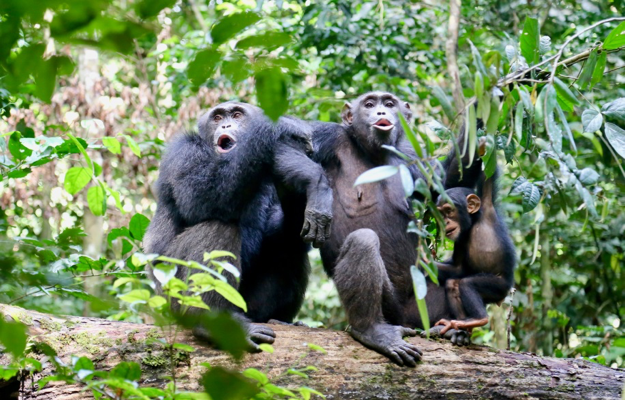 Evolution & Behaviour
Evolution & Behaviour
Human's impact on the behavior and cultural diversity of chimpanzees
Scientists rarely consider species’ behavioral diversity as a significant contributor to wildlife biodiversity. Challenging this view, we find that both behavioral and cultural diversity of wild chimpanzees are under threat from increasing anthropogenic impact.

Safeguarding the earth's biodiversity has become an urgent priority in the current era of unprecedented environmental and ecosystem degradation. Scientists have been monitoring the loss of species, populations, and their genetic diversity. However, they gave comparatively little attention to the influence of human growth and development on the behavior of animals. As such, we investigated whether the maintenance of behavioral traits and cultural traditions in one of our closest living relatives, chimpanzees, might suffer due to increasing human disturbance.
Chimpanzees, Pan troglodytes, have a diverse repertoire of behaviors they naturally use in the wild, including various forms of tool-use to access insects, meat, algae, and water. Besides, many chimpanzee behaviors are cultural, meaning that some populations have socially learned traits, but not all. Overall, chimpanzees, along with other non-human primates, cetaceans, and birds, show some of the best-studied examples of culture in animals.
For this study, we collected a large dataset on wild chimpanzee behaviors, of which more than half show cultural or population-specific variation in the wild. We combined data collected in the field via the Pan African Programme: the Cultured Chimpanzee with data on these behaviors mined from the published literature. In total, we compiled data on the presence (direct observation or indirect evidence such as tool artifacts, feeding remains, fecal samples) of these behaviors for 144 unique chimpanzee groups. We then identified an open-access map of the human footprint, created by a collaborative network of independent scientists. We used this map to test if chimpanzee groups living in areas with a high human footprint have lower diversity in the number of behaviors they exhibit. Here we observed for each chimpanzee group, the subspecies of chimpanzee, and geographic similarity between groups.
We found that chimpanzees living in high human impact environments showed far fewer of the behaviors investigated. On average, the probability these behaviors were present decreased by 88%. We also did not find any evidence for a particular behavior to be driving this pattern. We then verified that our results were not dependent on long or short-term research sites. The result holds: high human impact areas are associated with lower chimpanzee behavioral diversity than low impact areas. Many of the behaviors we investigated are also cultural. Therefore, we inferred that our results also reflect a reduction in chimpanzee cultural diversity in high human impact environments.
These results were not altogether surprising and confirmed many of our observations in the field. We witnessed first-hand the devastating effects of human activities such as deforestation, mining, and the bushmeat trade. However, with this study, we were able for the first time to empirically demonstrate the effects of our growing human footprint across the globe. Such an impact has repercussions not only for the loss of animal lives but also for the loss of the behavioral and cultural traits animals use in their day to day survival.
Although chimpanzees may adapt to living in close association with humans, for example, becoming more active at night or feeding on human crops, these behaviors are dangerous and risky. Therefore, if we wish to protect wild chimpanzee populations, then we must also consider conservation actions that safeguard their behavioral and cultural diversity. Our results, therefore, support the use of 'culturally significant units' to be used more generally in wildlife conservation. This approach has been previously designated and applied for whales. Even more pertinent, we advocate identifying chimpanzee' cultural heritage sites'. In these sites, locations, resources, and populations are protected to safeguard the behavioral and cultural diversity of the species’ for future generations. This will aid the conservation not only of wild chimpanzees but also of the rainforest and savanna woodland habitats they live in, as well as the accompanying biodiversity found in these environments. Such a concept could prove valuable for other wildlife, to encourage and support the protection of cultural traditions and social knowledge in species such as elephants, orangutans, macaques, capuchins, whales, and dolphins.
Original Article:
Kühl, H., Boesch, C., Kulik, L., Haas, F., Arandjelovic, M., Dieguez, P. et al. (2019). Human impact erodes chimpanzee behavioral diversity. Science, 363(6434), 1453-1455.Edited by:
Massimo Caine , Founder and Director
We thought you might like
Marine mammals may suffer dire consequences of ancient gene loss
Feb 8, 2019 in Evolution & Behaviour | 4 min read by Amanda KowalczykMachine-learning boosts the conservation of endangered plant species
Apr 29, 2019 in Plant Biology | 4 min read by Tara Pelletier , Anahí EspíndolaHigh extinction risk for wild coffee species and implications for coffee sector sustainability
Jul 5, 2019 in Plant Biology | 4 min read by Aaron P. DavisGone but not forgotten – plant extinction in modern times
Nov 29, 2019 in Earth & Space | 4 min read by A.M. Humphreys , R. Govaerts , E. Nic Lughadha , M.S. VorontsovaMore from Evolution & Behaviour
Rudimentary form of syntax present in chimpanzees
Nov 29, 2023 in Evolution & Behaviour | 3 min read by Maël LerouxAn incredibly massive ancient whale skeleton reveals a new way to become a giant
Nov 27, 2023 in Evolution & Behaviour | 4 min read by Olivier LambertVikings and Migrants: Unravelling Scandinavia's Genetic Mosaic in the Viking Era
Nov 13, 2023 in Evolution & Behaviour | 3 min read by Anders Götherström , Ricardo Rodríguez VarelaFish identify themselves in mirrors and portraits
Oct 18, 2023 in Evolution & Behaviour | 3.5 min read by Masanori Kohda , Satoshi Awata , Shumpei SogawaEditor's picks
Trending now
Popular topics


